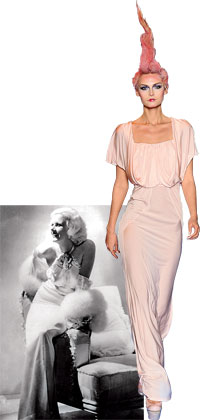Who says fashion and a tanking economy can’t mix? In the 1930s, more mending and less buying didn’t stifle some major developments: After years of 1920s boyishness, the female figure made a comeback, the surrealism movement expanded to apparel, and the decadence of Hollywood gained influence for the first time.
Whether embracing restraint or denial, some of today’s prescient designers pull inspiration from the depression era. This spring, who best embodies the prewar, post-crash spirit? We narrow it down to three aesthetic camps—and pick the winners.

DRIES VAN NOTE
restrained modern
Beliefs: Nostalgia is dead.
Wants: To look current without screaming it (Sorry, Balenciaga: no space warrior suits.)
1930s influence: sleek Art Deco
What it looked like then: Wide shoulders, nipped waistlines, neck details that highlighted the face
Today’s Winner: The graphic patterns at Dries Van Noten, sharply cut jackets and techno materials at YSL

ALEXANDER MCQUEEN
surrealism
Beliefs: People can be freed from false rationality and restrictive customs by stripping everyday objects of their normal significance.
Wants: To shock us into forgetting the economy entirely
1930s influence: André Breton, leader of the Surrealist movement
What it looked like then: Elsa Schiaparelli’s upside down shoe hat
Today’s winner: Alexander McQueen, who came out at the end of his delicate, dreamy show wearing a bunny suit
Photography: Dries Van Noten; Associated Press; Jacqueline Larma/Associated Press; Alexander McQueen; Associated Press; Galliano

JOHN GALLIANO
flamboyant romance
Beliefs: In tough times, we want more than ever to dream.
Wants: Concept shows and couture details
1930s influence: Hollywood fashion
What it looked like then: Bias-cut satin dresses, gold lamé, and chiffon
Today’s winner: The sweeping gowns at Galliano
Photography: Dries Van Noten; Associated Press; Jacqueline Larma/Associated Press; Alexander McQueen; Associated Press; Galliano


